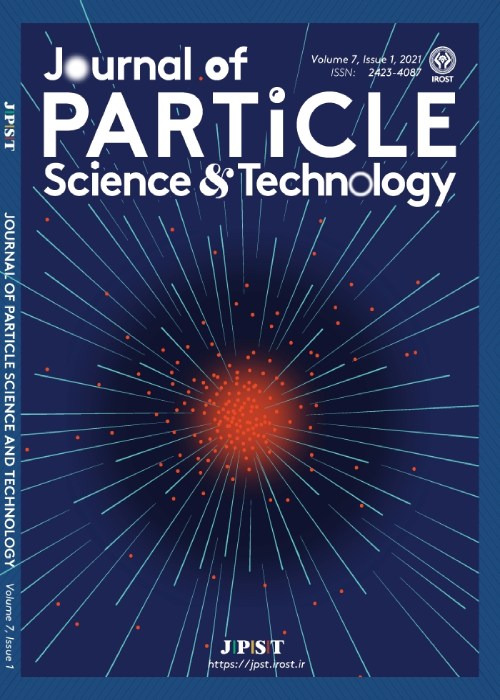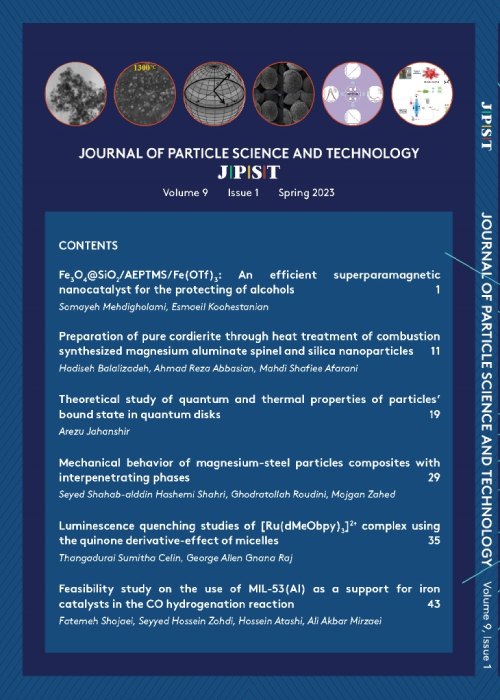فهرست مطالب

Journal of Particle Science and Technology
Volume:8 Issue: 2, Summer 2022
- تاریخ انتشار: 1402/03/17
- تعداد عناوین: 6
-
-
Pages 63-78
In the pharmaceutical industry, drug synthesis is usually carried out by batch method. However, in recent years, continuous methods, specifically microfluidics and microreactors, have attracted a great deal of attention due to advantages such as better mass and heat transfer, safety, selectivity, yield, and surface-to-volume ratio. Thus, in this review, different microreactor properties such as flow regime pattern, operating pressure, selectivity, safety, reaction phase, operating and control, materials, and cost are addressed and discussed. In addition, microreactor applications in the synthesis of chemicals and drugs, polymerization, nanoparticle synthesis, photochemical, biodiesel production, and catalytic microreactors are presented in detail. Furthermore, a comparison of the flow process of a pharmaceutical industry's microreactor and a batch reactor used for different APIs, intermediates, and lead compounds is presented. The results revealed that 50% of such reactions would show more promising results when carried out in a microreactor system, while only 44% of examined cases preferred such systems. Ultimately, these authors believe that the current review is very suitable for newcomers in pharmaceutical industry material production research who might be attracted to this new technology due to the elementary and basic microfluidics concepts discussed in the present manuscript.
Keywords: Microfluidic application, Microreactor, Micromixer, Pharmaceutical industry -
Pages 79-85In order to adjust the crystallite size and structure, NiFe2O4 was prepared in this study via a polyacrylamide gel method. Various characterization techniques like XRD, FT-IR, SEM, and VSM were used to learn more about the fabricated materials. The XRD corroborated that a crystalline NiFe2O4 phase with a cubic structure was produced. Microstructural studies showed that the produced particles have an irregular morphology with an average particle size of about 90 nm. The Williamson-Hall equation was utilized to examine the contributions of crystallite size and lattice strain of the samples. STA results showed the decomposition of the polymeric network gel during calcination. The crystallite size increases with increasing calcination temperatures, whereas the lattice strain slumps. The activation energy for crystallite growth was calculated to be 43.2 KJ.mol-1. VSM findings showed that saturation magnetization improves with temperature, which may be attributed to the crystallite growth of the particles. The coercivity of the samples dropped with an increase in the temperature.Keywords: NiFe2O4, Polyacrylamide gel, Magnetic properties, Nanomaterials
-
Pages 87-94In this paper, yttrium-substituted nickel ferrite (NiY2xFe2-2xO4) nanostructures were synthesized via the co-precipitation method with different concentrations of yttrium (x = 0.00, 0.02, 0.06, and 0.12 %, where x is the dopant concentration in molar percent) after calcination at 500 ºC. Structural studies of the samples were analyzed using X-ray diffractometry (XRD) technique. XRD results showed that the addition of Y led to an increase in synthesized nanoparticles. Molecular studies have been done using Fourier transform infrared (FT-IR) spectroscopy. FT-IR results showed that the bands at about 550-560 and 433 cm-1 are associated with tetrahedral and octahedral Metal-O bonds, respectively. Field emission scanning electron microscopy (FE-SEM) exhibit that adding Y3+ ions dopant up to x = 0.06 led to a considerable decrease in the powders’ particle size. Adding more dopant up to x = 0.12 led to an amorphous and crystalline phase formation. The size of nanoparticles before substitution estimated from FE-SEM images were 39.49, 36.49, and 50.78 nm, which increased to 63.07, 64.02, and 73.56 nm after the substitution, respectively. The magnetic behavior of the samples was investigated using vibrating sample magnetometry (VSM) at room temperature (RT). VSM results showed that the saturation magnetization and coercivity (Hc) values decreased with the increase of yttrium contents up to x = 0.12. This was referred to as the redistribution of cations on the octahedral bonds.Keywords: Yttrium-nickel ferrite, ferromagnetic, saturation magnetization, coercivity
-
Pages 95-102The main purpose of this research is to investigate the effect of doped nanoparticles on the thermal conductivity of nanofluids. ZnO, CuO, and Zn1-XCuXO doped nanoparticles were first fabricated by the sol-gel auto-combustion method using glycine as fuel with different molar ratios of glycine/metal ions. Different values of X = 0.02, 0.03, 0.04, 0.06, 0.07, and 0.08 were used to fabricate the Zn1-XCuXO doped nanoparticles. The X-ray diffraction patterns showed that the substitution of Zn atoms with Cu atoms was completed for X = 0.02 and 0.03, so X = 0.03 was obtained as the solubility limit for fabricating Zn1-XCuXO doped nanoparticles. The Zno, CuO, and Zn0.97Cu0.03O doped nanoparticles were then used as an additive to prepare ethylene glycol-based nanofluids with different nanoparticle concentrations. The results showed the highest observed thermal conductivity enhancement was 12.5 % and related to the nanofluid containing Zn0.97Cu0.03O doped nanoparticles at a concentration of 0.5 wt%. Moreover, adding Cu to the ZnO structure increased the thermal conductivity of the ethylene glycol-based nanofluid containing Zn0.97Cu0.03O doped nanoparticles due to its high thermal conductivity.Keywords: sol-gel auto-combustion method, zinc oxide, doped nanoparticles, Nanofluids, Thermal Conductivity
-
Pages 103-114The objective of this work was to evaluate the efficiency of a promising ultrasonically assisted adsorption with the Fe3O4@THAM-CH2CH2Cl magnetic nanoparticle (MNPS) as a new adsorbent for the elimination of Congo red from water samples. The FE-SEM images show that Fe3O4@THAM-CH2CH2Cl MNPs adsorbent is spherical. Due to the presence of pores on the Fe3O4@THAM-CH2CH2Cl MNPs adsorbent surface, the proposed adsorbent can remove Congo red from the aqueous environment by trapping the pollutant in its pores. Different parameters influencing the ultrasonically assisted adsorption (UAA) by the Fe3O4@THAM-CH2CH2Cl MNPs adsorbent, including the dye concentration and adsorbent mass, ultrasonic time, and pH, were studied and optimized by multivariate methods. The best adsorption efficiency was obtained at 0.04 g of adsorbent, 17 mg.L-1 of dye, pH = 6.6, and ultrasonic treatment for 7.2 min. The results indicated that the efficiency of dye adsorption ranged from 97.85 to 99.65 %. The kinetic, isotherm, and thermodynamic for the proposed method were assayed. The larger R2 for the pseudo-second kinetic model indicates that this model is more suitable to describe the adsorption process of Congo red on the Fe3O4@THAM-CH2CH2Cl MNPs adsorbent. The Langmuir adsorption isotherm had a larger correlation coefficient (R2 = 0.9987), which indicates it fits best with the experimental data and is more suitable for the Congo red adsorption process. Analysis of actual samples showed that Congo red removal values (R %, mean ± standard deviation, n = 3) in tap water and wastewater were 98.48 ± 1.52 % and 98.05 ± 2.11 %, respectively.Keywords: Congo red, Fe3O4@THAM-CH2CH2Cl, Multivariate methods, Wastewater
-
Pages 115-119ZnS is a wide band gap semiconductor with excellent optical and electrical properties whose electronic structure can be modified with other semiconductors. In this study, ZnS and ZnS/ZnO heterostructure semiconductors were fabricated using the reaction between ZnCl2 and Na2S in the presence and absence of ethyl pyridinium iodide ionic liquid media via a reflux route without calcination. The as-prepared samples were characterized by XRD, FE-SEM, EDS, and DRS techniques. The main observations were the effects of ethyl pyridinium iodide on structural features, morphology, and band gap. The XRD patterns of ZnS represented peaks at 2θ = 8.8, 28.6, 32.9, 47.6, 56.4, 69.7, 76.9º of the blende structure. The crystalline nature of ZnS/ZnO at 29.05, 34.43, 47.51, 56.57, 69.06º and 31.80, 36.26, 47.51, 56.57, 62.85, 66.38, 67.90º is compatible with the standard pattern of ZnS blende and ZnO Zincite phases, respectively. The ZnS/ZnO heterostructure showed that the crystal truncated hexagonal had a thickness of about 90 nm. The rough hexagonal contained several layers, and the averaged elemental enrichment of Zn : S : O was 1 : 0.29 : 0.67. The synergistic effects of ZnS and ZnO promoted band-gap narrowing compared to the ZnS blende particles. So, in the ZnS and ZnS/ZnO cases, the band gap energy was 4.17, and 2.82 eV, respectively. The proposed ZnS/ZnO heterostructure composite has potential applications in semiconductors. The findings of this study opened new aspects of ZnO/ZnS heterostructure in terms of preparation, morphology, and band gap value.Keywords: ZnS, ZnO heterostructure, Ethyl pyridinium iodide, Narrow band gap, Reflux route


